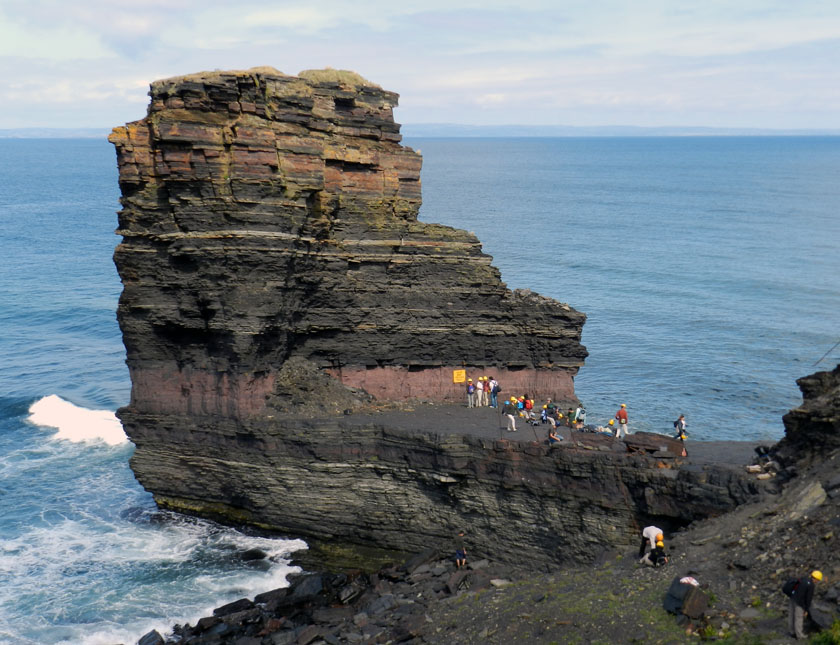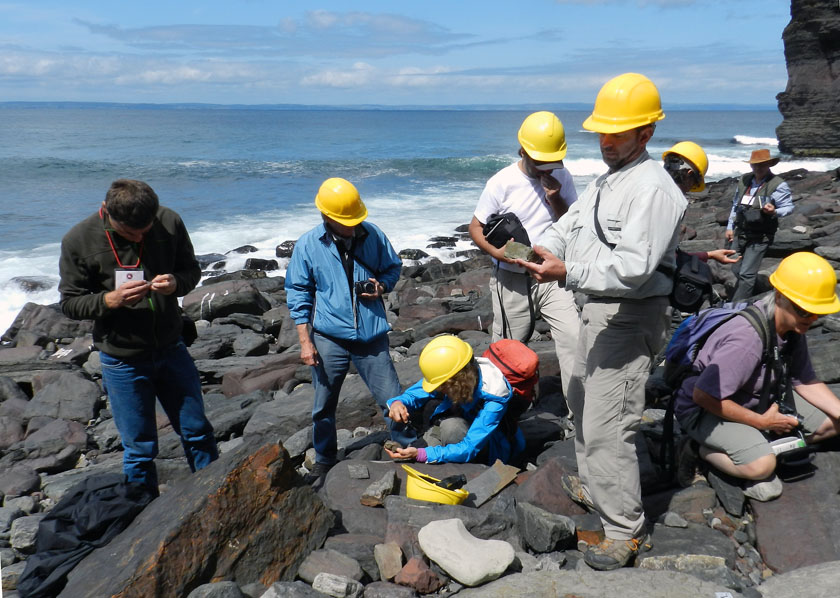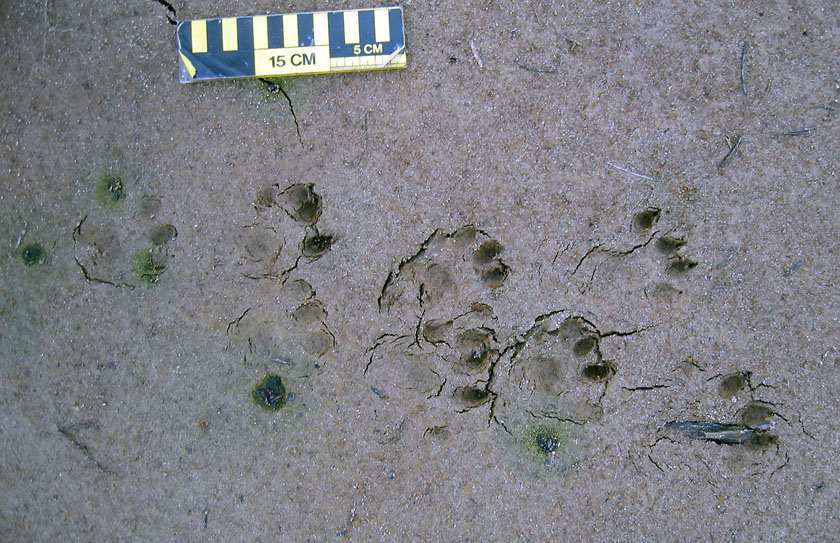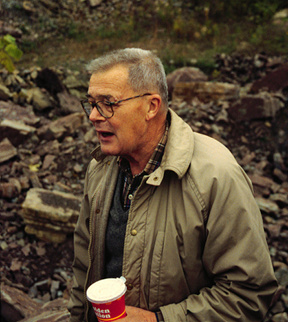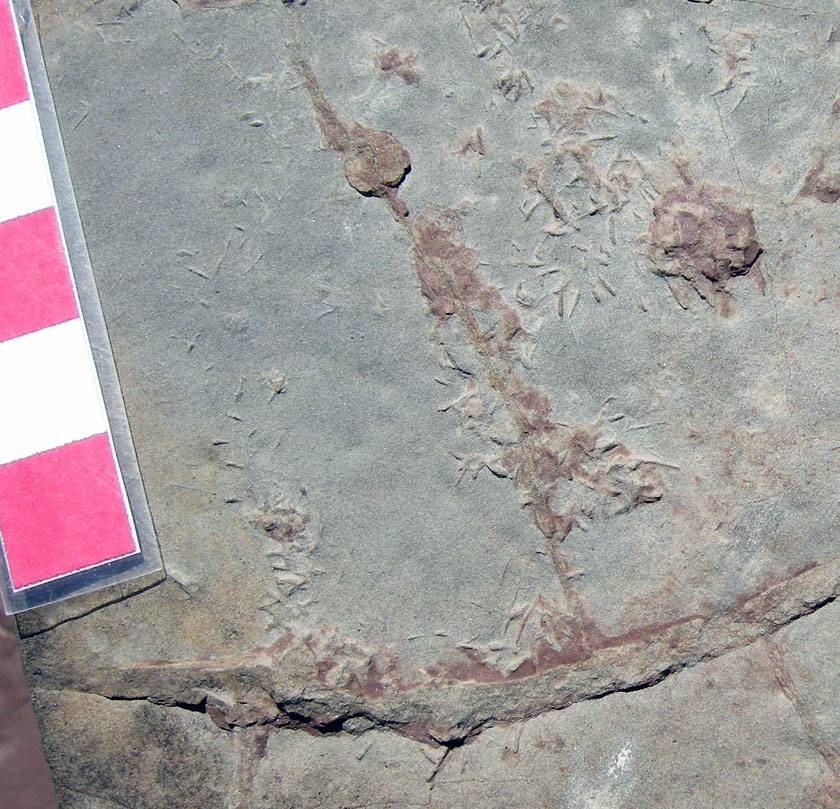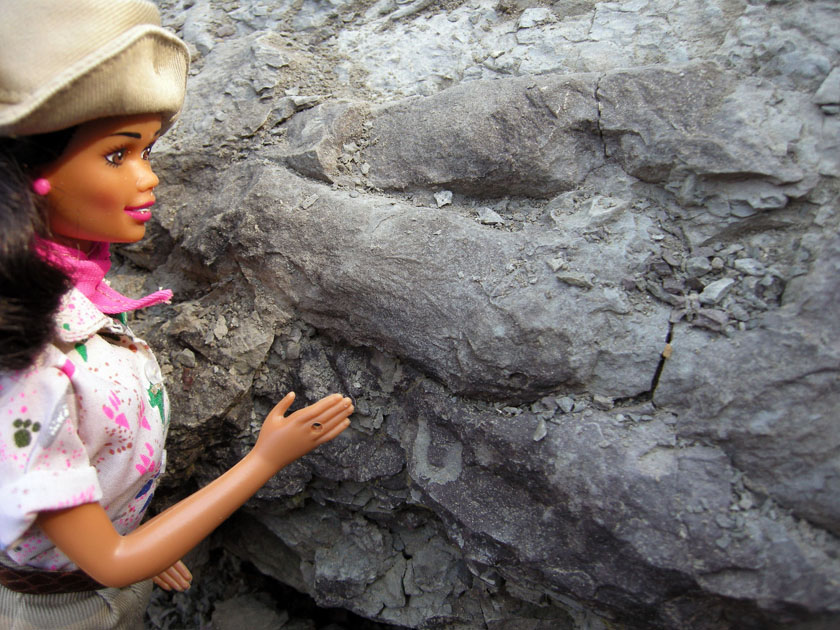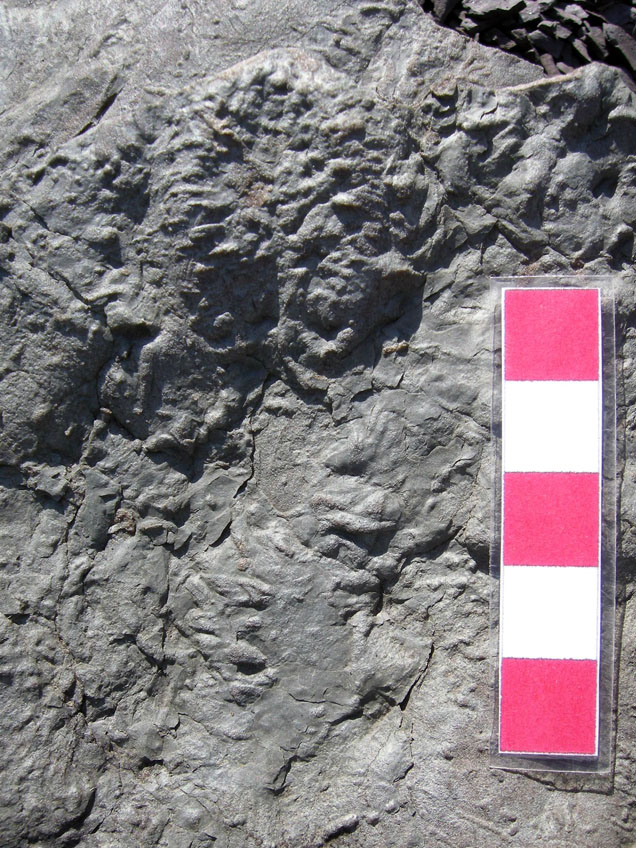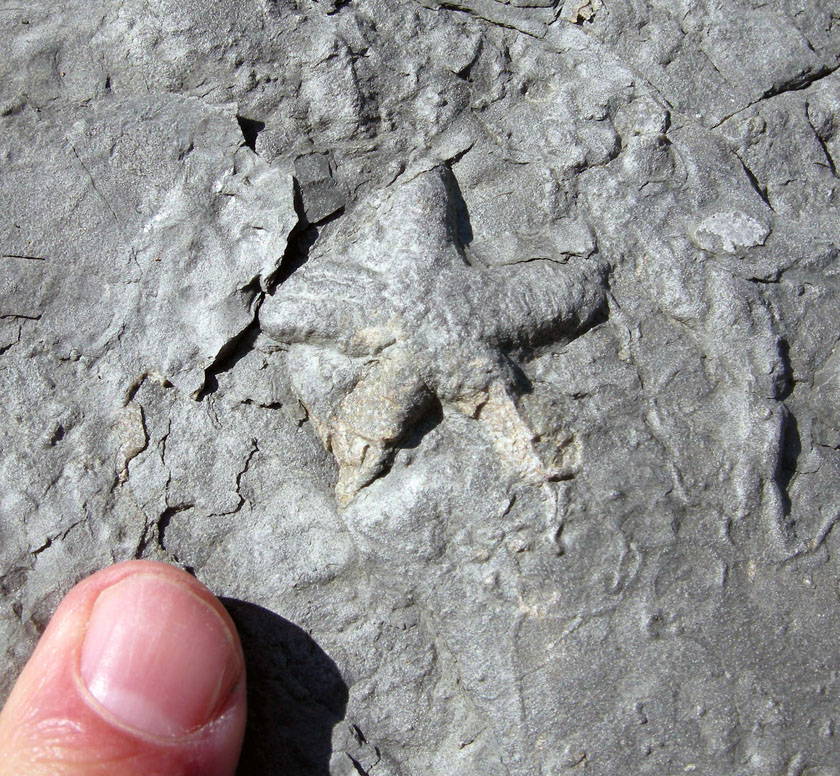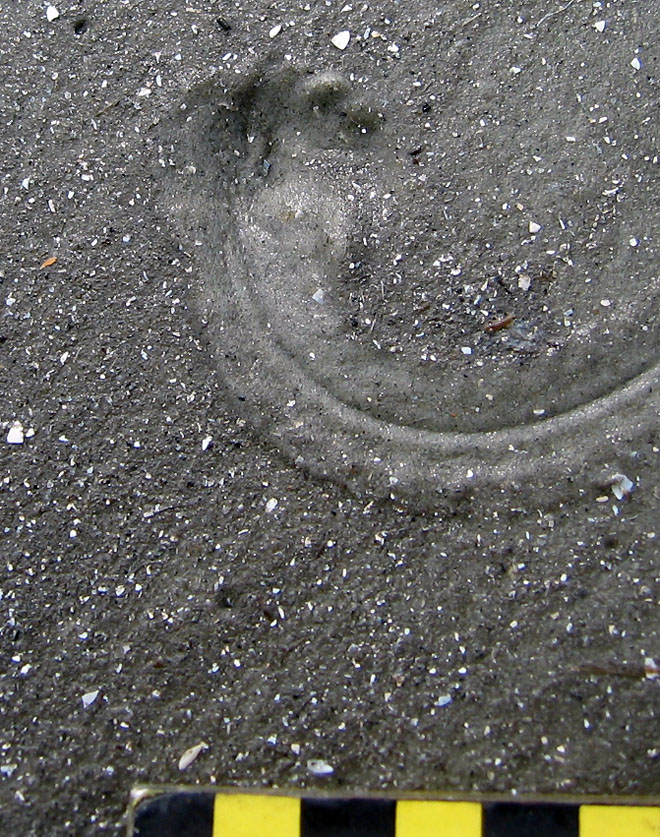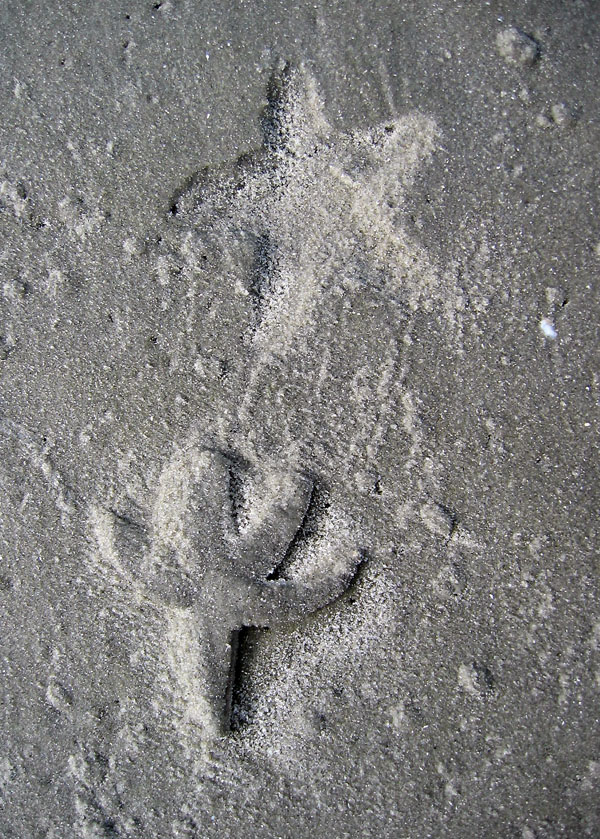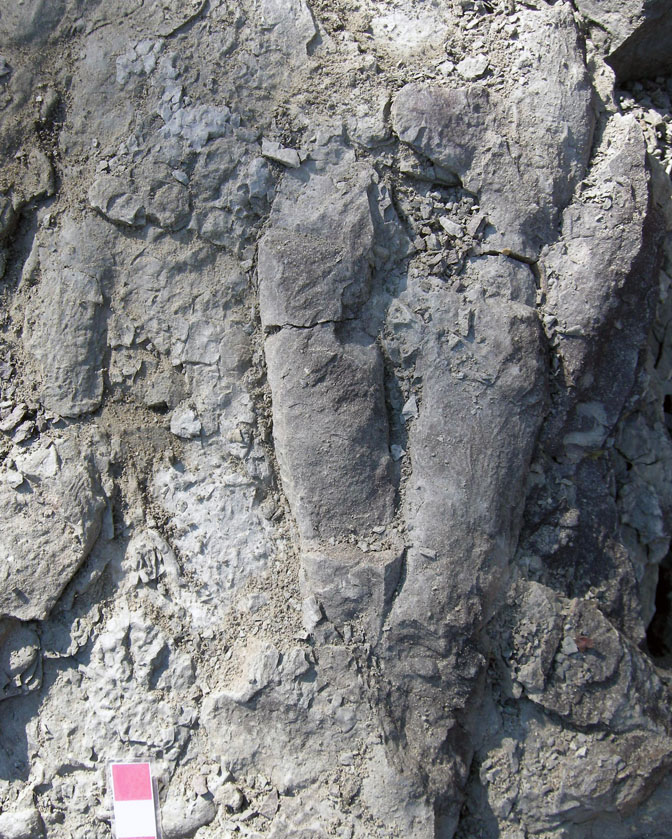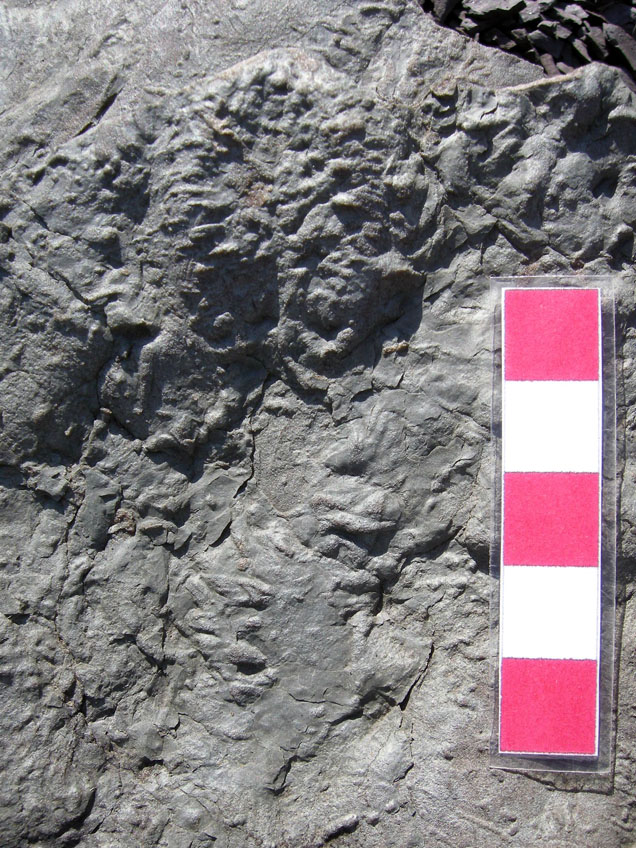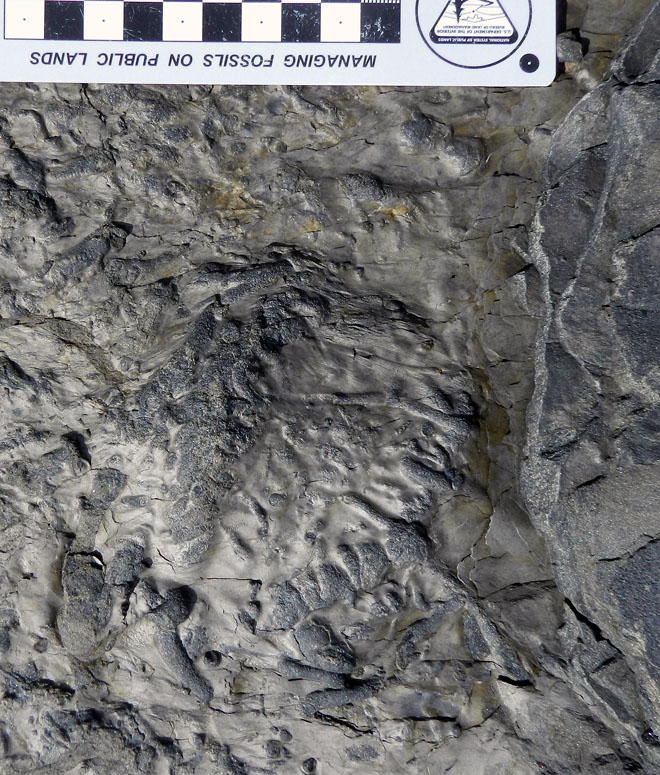It might seem a bit strange to consider traveling back 450 million years as a “homecoming.” But geologists time travel often enough to qualify as Time Lord apprentices, regardless of whether we are traveling by phone booth, car, or on foot. What creates this situation is how geologists may experience much of their training, teaching, or research interests in rocks of a certain age, gaining a certain comfort level when dealing with the earth of that time.
 “Hey everyone, let’s go to the Ordovician!” “Sounds good to me. Road trip!” You can do this when you live in a place with abundant, fantastically preserved, and freely available fossils. Which incidentally describes the area around Cincinnati, Ohio. (Photo by Anthony Martin.)
“Hey everyone, let’s go to the Ordovician!” “Sounds good to me. Road trip!” You can do this when you live in a place with abundant, fantastically preserved, and freely available fossils. Which incidentally describes the area around Cincinnati, Ohio. (Photo by Anthony Martin.)
For me, my most recent homecoming was to the Ordovician Period, a geologic time span of about 488-444 million years ago. As a geologic period, its life and marine environments are represented quite well by the world-class fossil-bearing limestones and shales in and around the area of Cincinnati, Ohio. This is where I gained my formative training as a paleontologist, as I studied Ordovician rocks and fossils in the area while working on an M.S. degree in geology at Miami University in the mid-1980s. (Incidentally, Miami was a university before Florida was a state, and the rocks around it are much older than any in Florida, too. As a matter of pride, then, I like to inform people that I went to the “real” Miami.)
So last month I was lucky enough to participate in two field trips and a paleontology mini-conference in the region of Cincinnati, Ohio, which felt very much like a homecoming. The field trips and conference were co-sponsored by: the myFOSSIL Project, an NSF-funded initiative working to unite avocational (“amateur”) fossil collectors with professional paleontologists while enhancing STEM (Science Technology Engineering and Math) through the science of paleontology; The Dry Dredgers, a fossil-collecting club founded in 1942 (!) in Cincinnati, and consisting of some of the most knowledgeable and enthusiastic collectors I’ve met anywhere; the Cincinnati Museum Center, which hosted the conference and keynote talk (more on that soon); and the Paleontological Society, which was ably represented at the mini-conference by their current president, past president, and other officers and members.
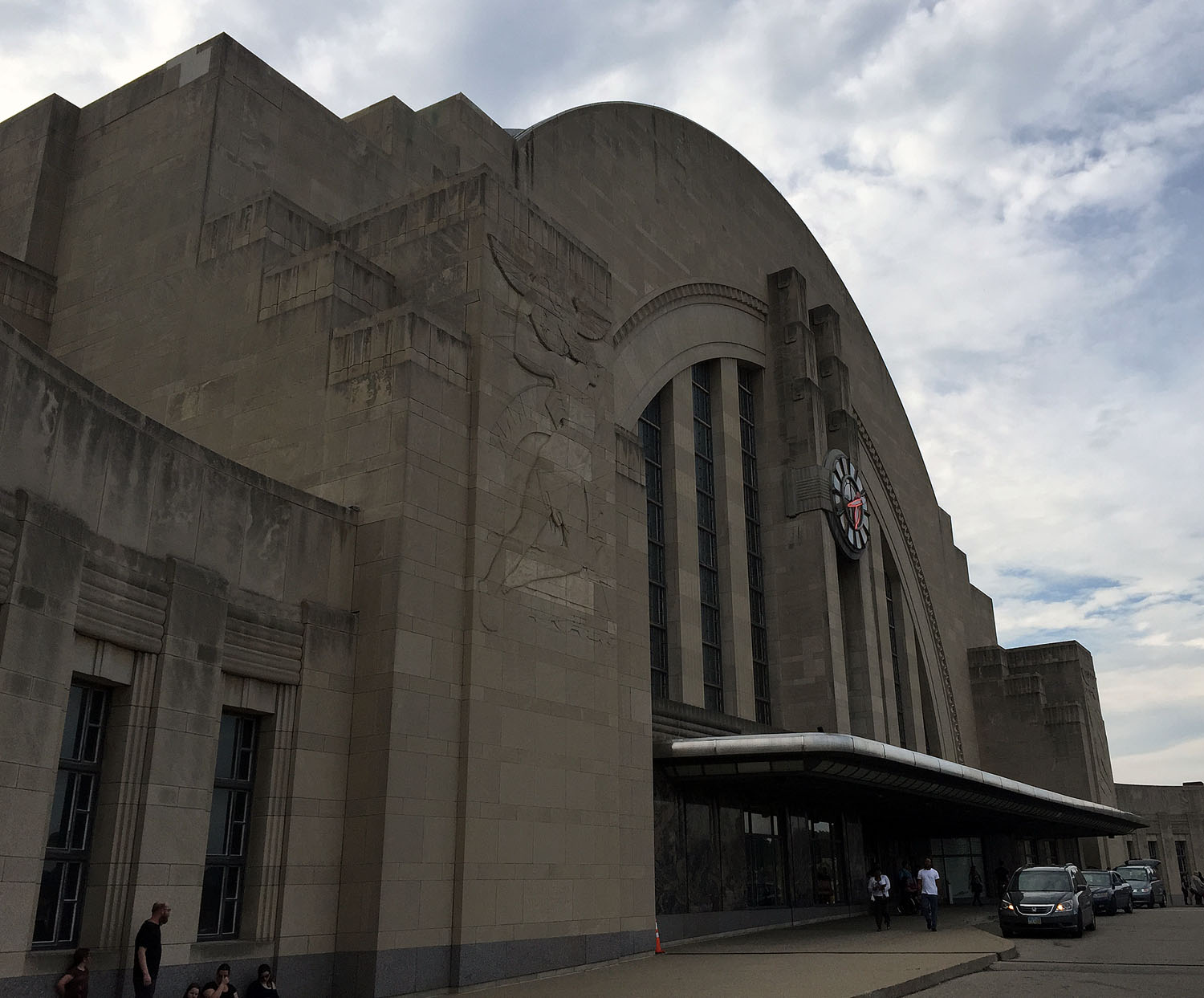 Exterior of the Cincinnati Museum Center, which helped to host the Paleontology Mini-Conference, houses a fantastic collection of Ordovician-age fossils, and served as the venue for a keynote talk given by Yours Truly. The museum building originated as the Cincinnati Union Terminal in 1933 and was later converted into the museum in 1990. It’s a very neat place for both its art-deco architecture and its displays, and every visit to the Cincinnati area should include it. Right after having some Skyline Chili and Graeters Ice Cream, that is. (Photo by Anthony Martin.)
Exterior of the Cincinnati Museum Center, which helped to host the Paleontology Mini-Conference, houses a fantastic collection of Ordovician-age fossils, and served as the venue for a keynote talk given by Yours Truly. The museum building originated as the Cincinnati Union Terminal in 1933 and was later converted into the museum in 1990. It’s a very neat place for both its art-deco architecture and its displays, and every visit to the Cincinnati area should include it. Right after having some Skyline Chili and Graeters Ice Cream, that is. (Photo by Anthony Martin.)
Already I’ve listed many reasons for being there, but the main incentive was as the keynote speaker for the mini-conference, an invitation I received and gratefully accepted late last year. For that, I gave a public lecture at the Cincinnati Museum Center on a Friday night, and on the topic of my most recent book, Dinosaurs Without Bones (2014). I had my usual fun time with the lecture, the audience had a variety of thoughtful questions for me to answer and otherwise discuss, and I happily did a book signing afterwards. We were then given a tour of the museum, which has world-class Ordovician fossils in it and much more.
Sound great? It was. But the real highlight of my journey was seeing the Ordovician rocks and fossils in the area. Hence I had to participate in the pre-meeting and post-meeting field trips to various roadcuts in Kentucky, Indiana, and Ohio while there. As an ichnologist, I was was also keenly interested in revisiting the trace fossils in these rocks, which I had not seen in a long time (by human standards). Accordingly then, the following photos show some of the people and outcrops we visited, but really focus on the coolest trace fossils I saw, accompanied by my attempts to explain each.
Many thanks to everyone who made the 2016 Cincinnati Paleontology Mini-Conference happen, and much appreciation for taking me back “home” to the Ordovician.
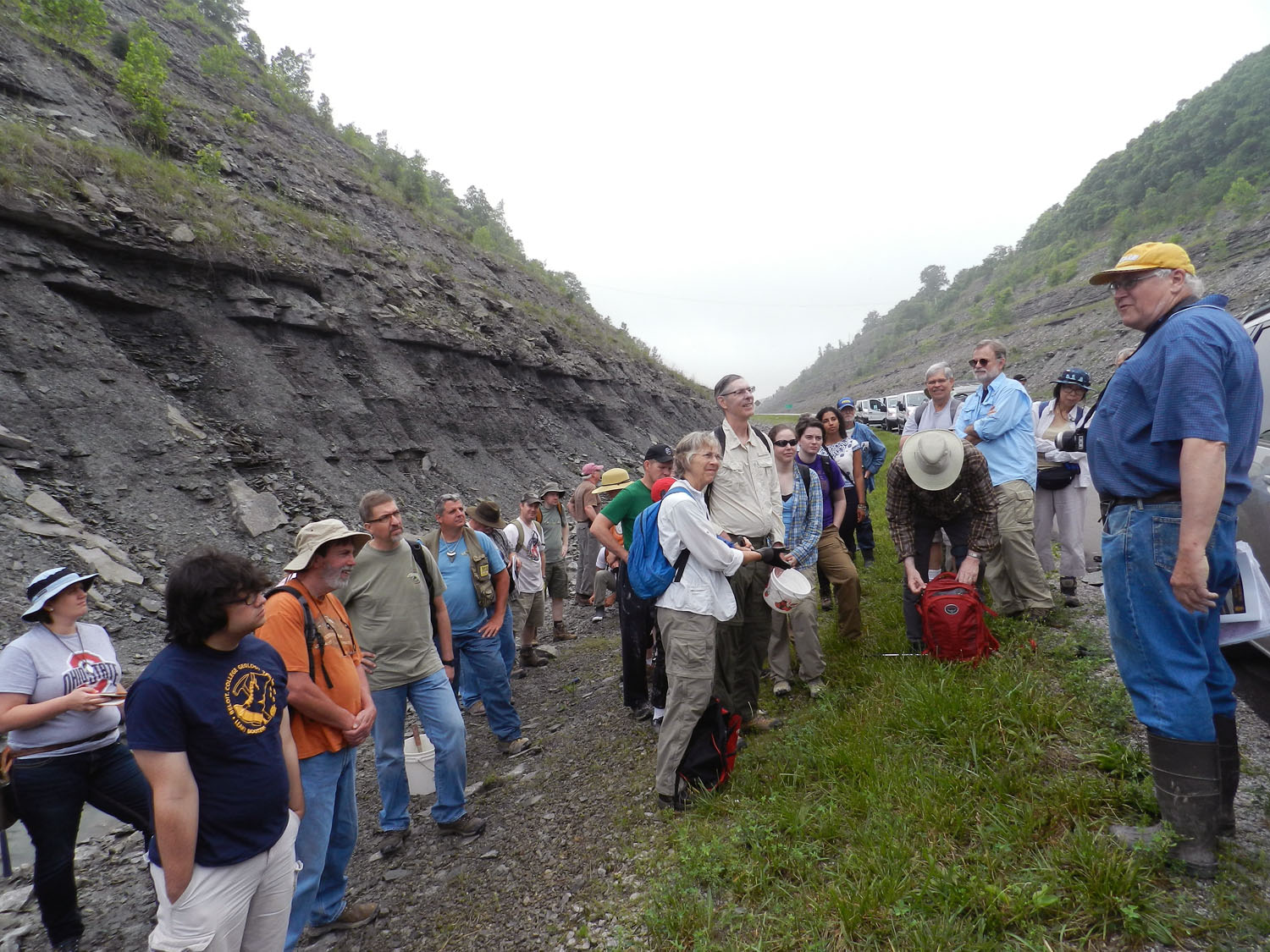 The pre-meeting field trip and part of the post-meeting trip benefited from the presence of the indefatigable Dr. Carl Brett from the University of Cincinnati. I am continually awed by both his knowledge of the Ordovician rocks and fossils and his unrestrained enthusiasm for sharing this knowledge. Even better, he loves trace fossils, which officially makes him my new best friend. (Photo by Anthony Martin.)
The pre-meeting field trip and part of the post-meeting trip benefited from the presence of the indefatigable Dr. Carl Brett from the University of Cincinnati. I am continually awed by both his knowledge of the Ordovician rocks and fossils and his unrestrained enthusiasm for sharing this knowledge. Even better, he loves trace fossils, which officially makes him my new best friend. (Photo by Anthony Martin.)
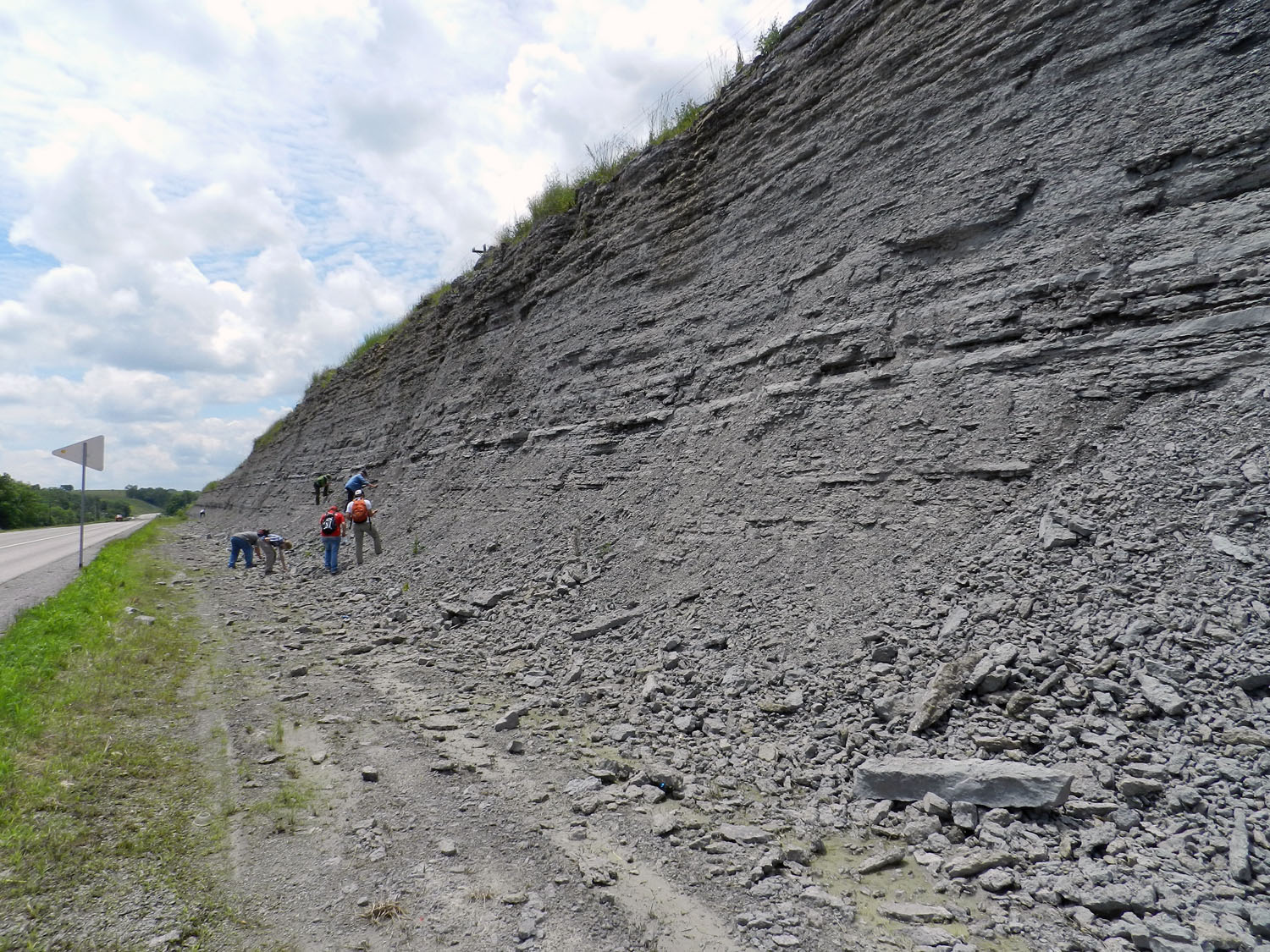 Roadcuts like these, all chock full of Ordovician body fossils and trace fossils, make me and other paleontological connoisseurs very happy. (Photo by Anthony Martin.)
Roadcuts like these, all chock full of Ordovician body fossils and trace fossils, make me and other paleontological connoisseurs very happy. (Photo by Anthony Martin.)
 Carl Brett found these gorgeous trilobite resting traces at the very first outcrop, which at first made me a little jealous, but I got over it quickly enough after staring at these beauties for a few minutes. These were probably made by a species of Flexicalymene, which burrowed down into a firm mud below, possibly to hide from predators but also as shelter from other problems above. Later, silt and fine sand filled in the depressions, making these natural casts. Be sure to look for the little trilobite tracks, too.
Carl Brett found these gorgeous trilobite resting traces at the very first outcrop, which at first made me a little jealous, but I got over it quickly enough after staring at these beauties for a few minutes. These were probably made by a species of Flexicalymene, which burrowed down into a firm mud below, possibly to hide from predators but also as shelter from other problems above. Later, silt and fine sand filled in the depressions, making these natural casts. Be sure to look for the little trilobite tracks, too.
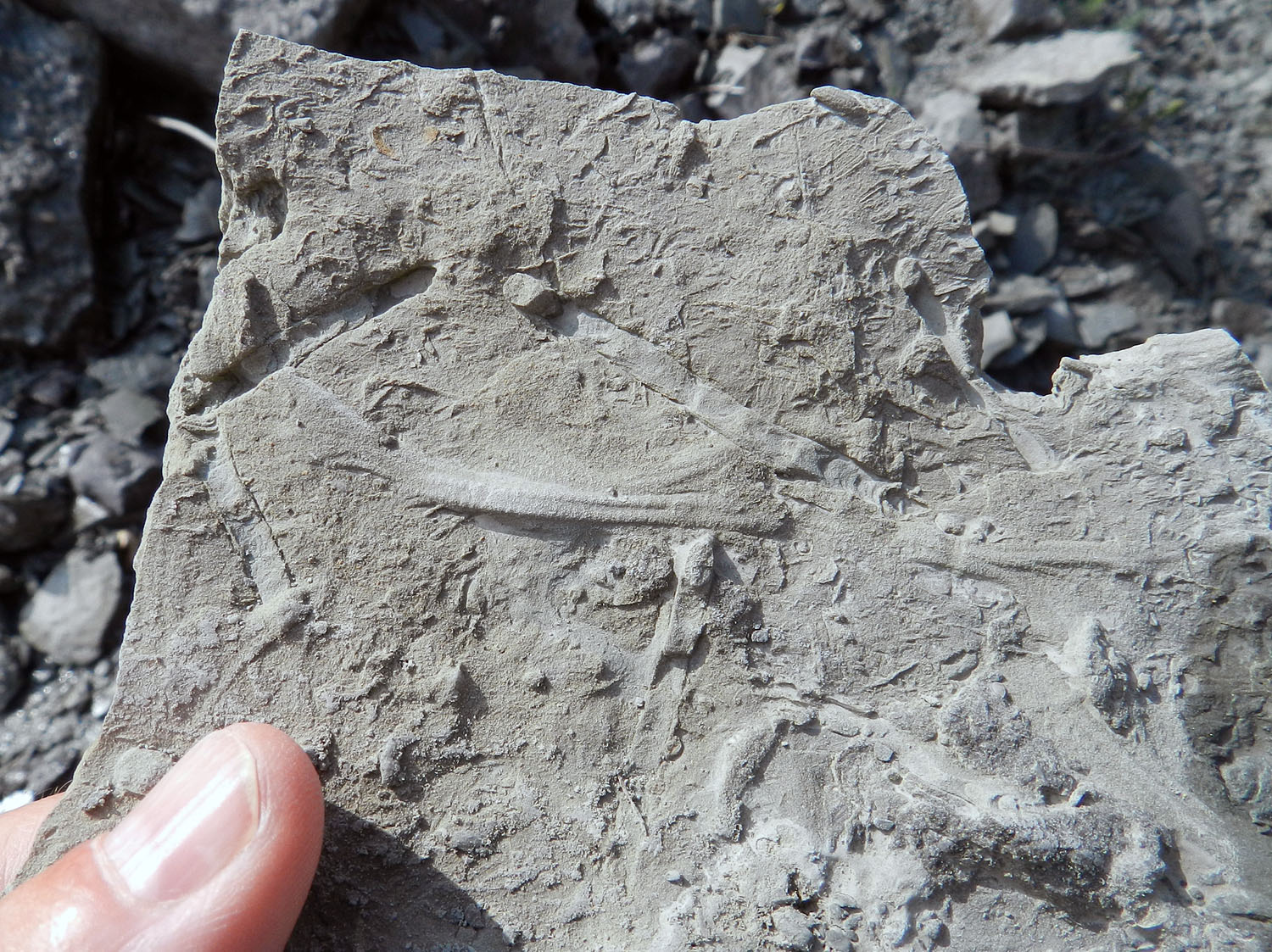 How about the cutest trace fossil I saw? Here’s a tiny trilobite burrow I found on the bottom of a siltstone bed (my thumb is pointing to it). The dual pathways mark where its little legs pushed down and into the sediment below it; it have been made by a juvenile or full-sized adult that just happened to be really small. It is again preserved as a natural cast, so you’re looking at the bottom of the bed. (Photo by Anthony Martin.)
How about the cutest trace fossil I saw? Here’s a tiny trilobite burrow I found on the bottom of a siltstone bed (my thumb is pointing to it). The dual pathways mark where its little legs pushed down and into the sediment below it; it have been made by a juvenile or full-sized adult that just happened to be really small. It is again preserved as a natural cast, so you’re looking at the bottom of the bed. (Photo by Anthony Martin.)
 Most of these trace fossils are compressed and intersecting horizontal burrows, which are visible because they are filled with a different sediment than the surrounding rock. Notice smaller-diameter and more complicated burrow system to the right, which apparently was made first, as the other burrows cut across it. Both were likely feeding burrows made by worm-like animals. (Photo by Anthony Martin.)
Most of these trace fossils are compressed and intersecting horizontal burrows, which are visible because they are filled with a different sediment than the surrounding rock. Notice smaller-diameter and more complicated burrow system to the right, which apparently was made first, as the other burrows cut across it. Both were likely feeding burrows made by worm-like animals. (Photo by Anthony Martin.)
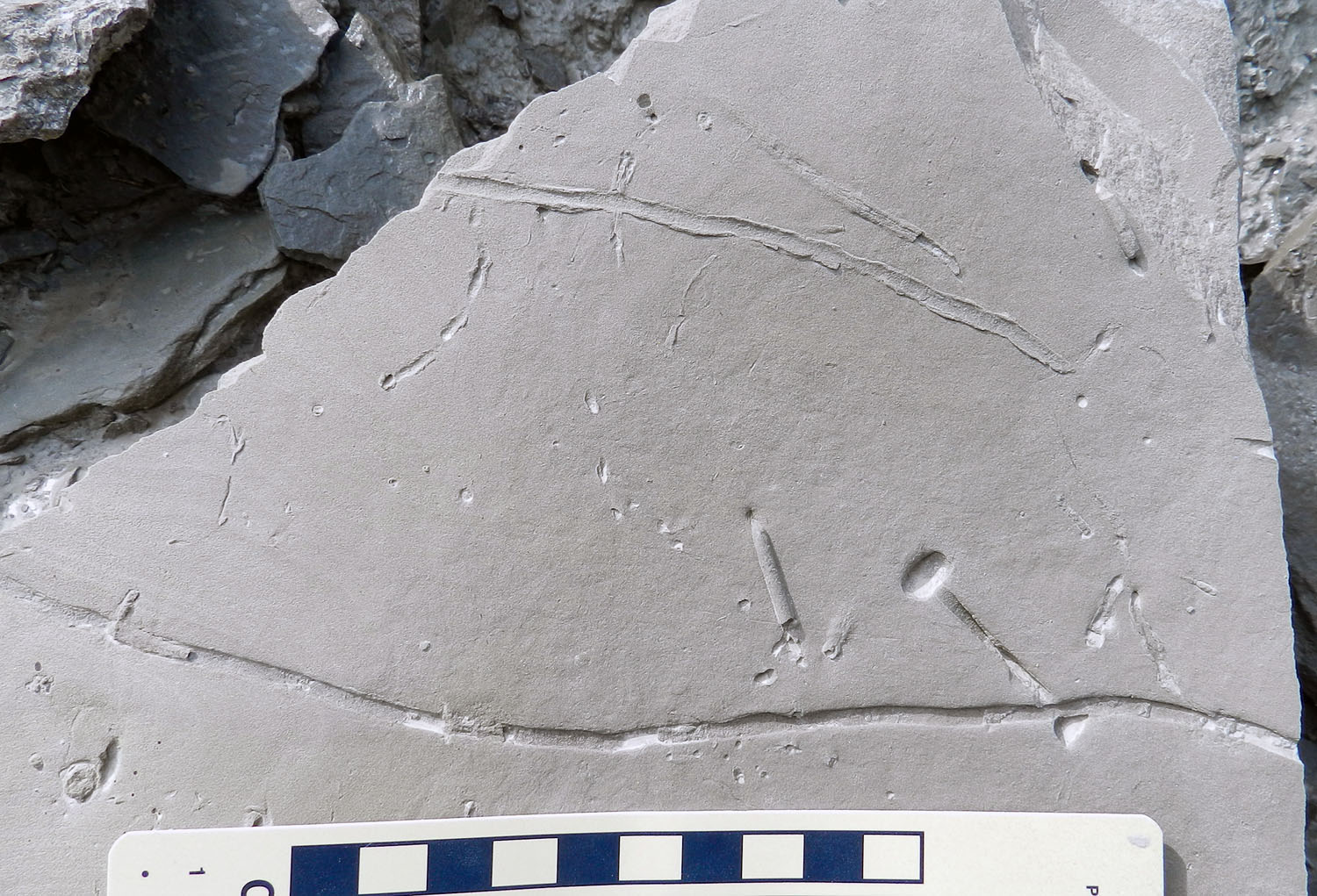 At least four different types of trace fossils are on this slab: the little “pockmarks” that also show some branching; the lined burrow toward the top of the slab (eroded so that it looks like a snail trail); the long, discrete burrow just above the scale, and the “dumbell” one on the lower right. Applying the principle of cross-cutting relations, can you work out the sequence of which burrow came first, second, third, and last? All were likely made by wormy critters and are feeding burrows, although the “dumbell” burrow also served as a home, as we’re looking at the top of a U-shaped burrow. More on that with the next photo… (Photo by Anthony Martin.)
At least four different types of trace fossils are on this slab: the little “pockmarks” that also show some branching; the lined burrow toward the top of the slab (eroded so that it looks like a snail trail); the long, discrete burrow just above the scale, and the “dumbell” one on the lower right. Applying the principle of cross-cutting relations, can you work out the sequence of which burrow came first, second, third, and last? All were likely made by wormy critters and are feeding burrows, although the “dumbell” burrow also served as a home, as we’re looking at the top of a U-shaped burrow. More on that with the next photo… (Photo by Anthony Martin.)
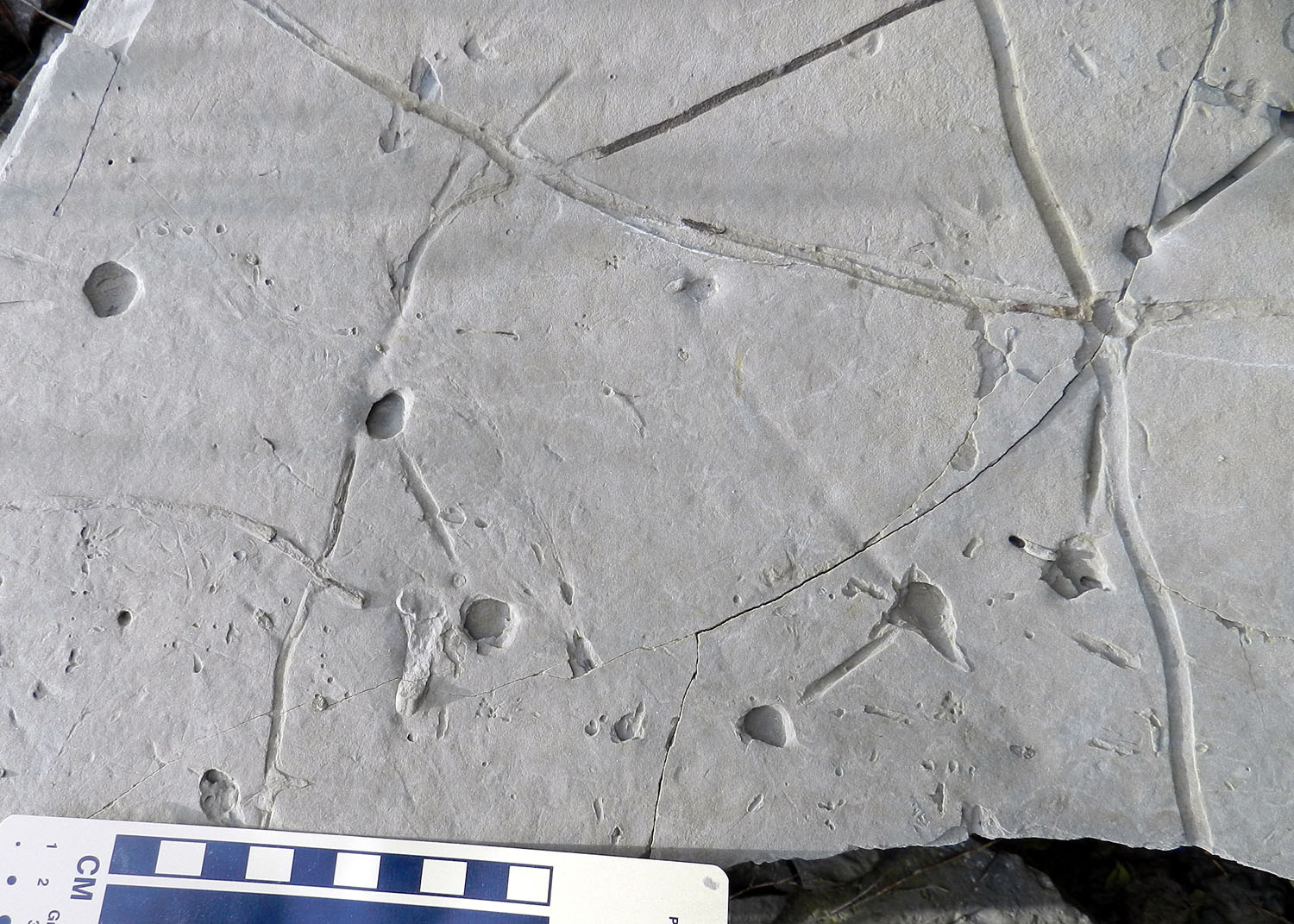 The trace fossils on this surface are similar to that of the previous one, but has a lot more “dumbells,” which represent U-shaped burrows that were originally tubular, with the critter – maybe a worm, maybe a crustacean – having its head close to one opening and its rear end close to the other. To visualize these burrows in three dimensions, make a “U” with your thumb and forefinger, turn it so you are looking at the tips of your fingers, and imagined a line of collapsed sediment between the two limbs of the “U.” (Photo by Anthony Martin.)
The trace fossils on this surface are similar to that of the previous one, but has a lot more “dumbells,” which represent U-shaped burrows that were originally tubular, with the critter – maybe a worm, maybe a crustacean – having its head close to one opening and its rear end close to the other. To visualize these burrows in three dimensions, make a “U” with your thumb and forefinger, turn it so you are looking at the tips of your fingers, and imagined a line of collapsed sediment between the two limbs of the “U.” (Photo by Anthony Martin.)
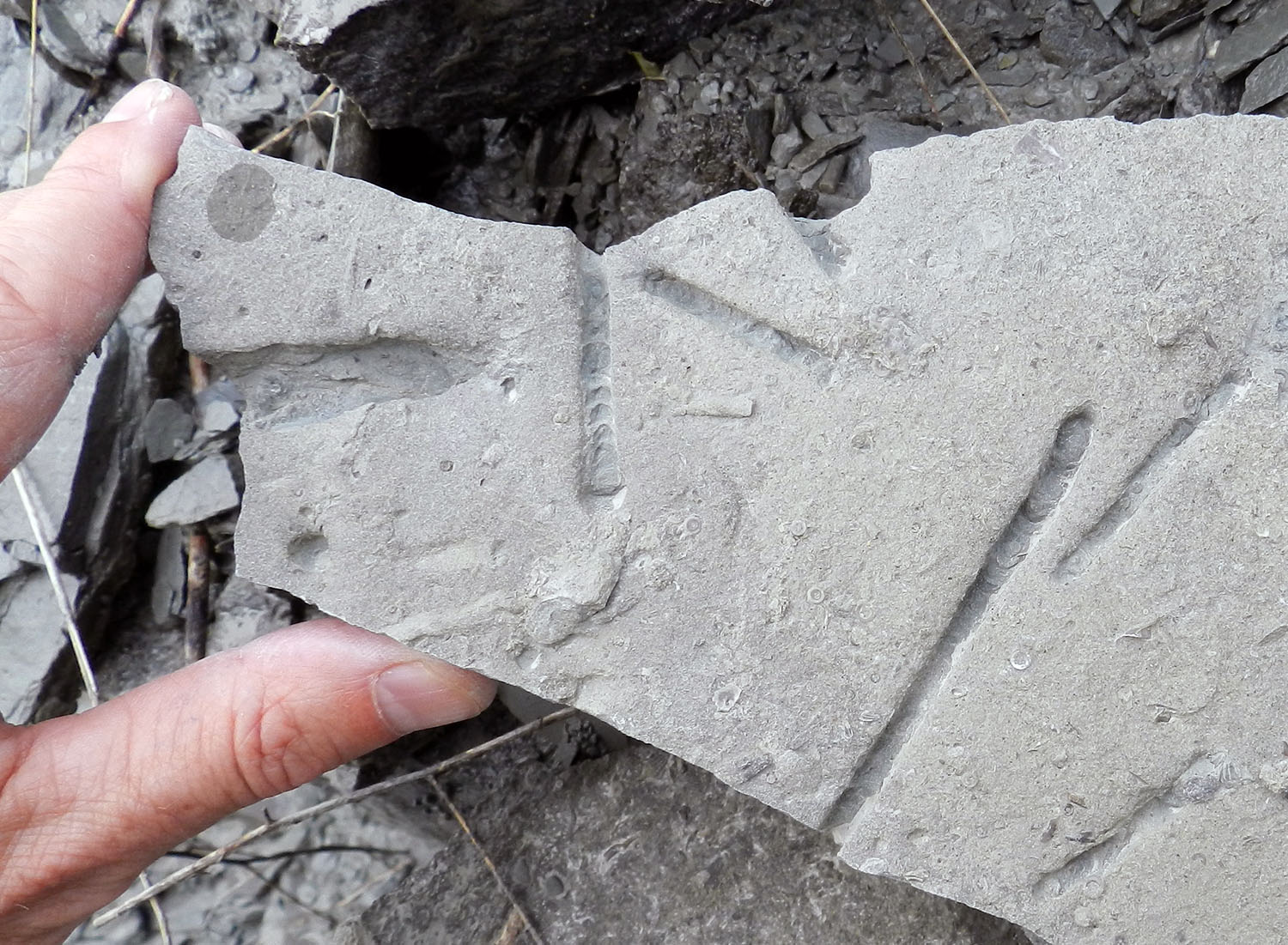 These are bottom expressions of the U-shaped burrows, but omitting the tubes. The curved lines inside the linear parts show where the maker of the U-shaped burrow moved its burrow up or down in response to what was happening on the surface. A little confused by that? You’re not alone, and welcome to my world. (Photo by Anthony Martin.)
These are bottom expressions of the U-shaped burrows, but omitting the tubes. The curved lines inside the linear parts show where the maker of the U-shaped burrow moved its burrow up or down in response to what was happening on the surface. A little confused by that? You’re not alone, and welcome to my world. (Photo by Anthony Martin.)
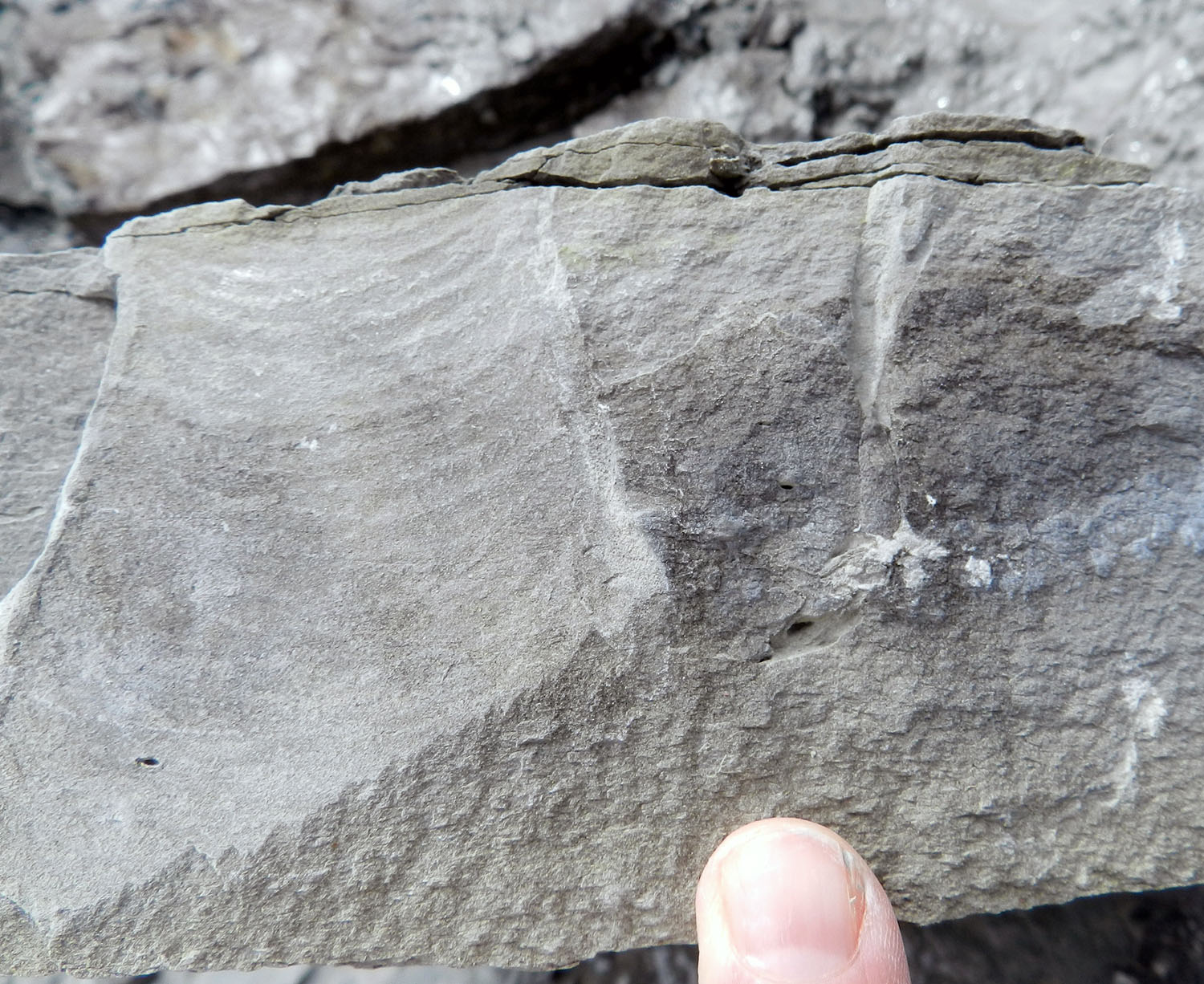 Here are partial vertical sections of two U-shaped burrows, with the one on the left also displaying the internal structure made by animal as it moved its burrow up or down, depending on whether it had sediment dumped on top of its burrow (move up!) or the top was eroded (move down!). I think this one went down, but can’t say for sure without seeing the burrow bottom, which is not preserved here. (Photo by Anthony Martin.)
Here are partial vertical sections of two U-shaped burrows, with the one on the left also displaying the internal structure made by animal as it moved its burrow up or down, depending on whether it had sediment dumped on top of its burrow (move up!) or the top was eroded (move down!). I think this one went down, but can’t say for sure without seeing the burrow bottom, which is not preserved here. (Photo by Anthony Martin.)
 This branching burrow, which if reconstructed in three dimensions would look like an upside-down bush, was made by an animal (or several with their burrows overlapping) feeding on the sediment. The branches are from repeated probing into the surrounding sediment, then withdrawing, then probing again. (Photo by Anthony Martin.)
This branching burrow, which if reconstructed in three dimensions would look like an upside-down bush, was made by an animal (or several with their burrows overlapping) feeding on the sediment. The branches are from repeated probing into the surrounding sediment, then withdrawing, then probing again. (Photo by Anthony Martin.)
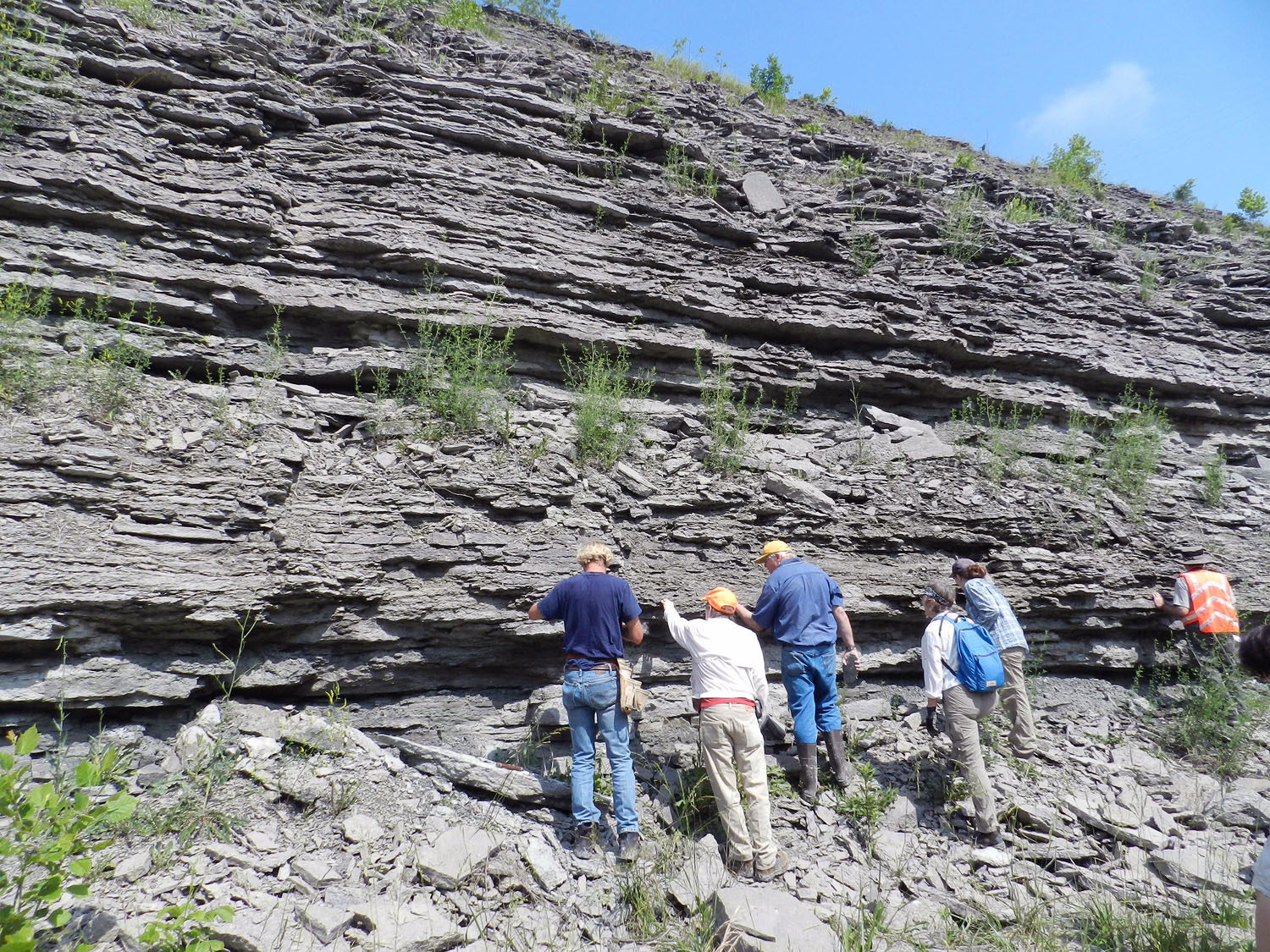 What other trace fossils are in these outcrops of Ordovician limestones and shales? Too many for these people to see them all and study, but clearly they don’t care. And that’s a good thing. (Photo by Anthony Martin.)
What other trace fossils are in these outcrops of Ordovician limestones and shales? Too many for these people to see them all and study, but clearly they don’t care. And that’s a good thing. (Photo by Anthony Martin.)

